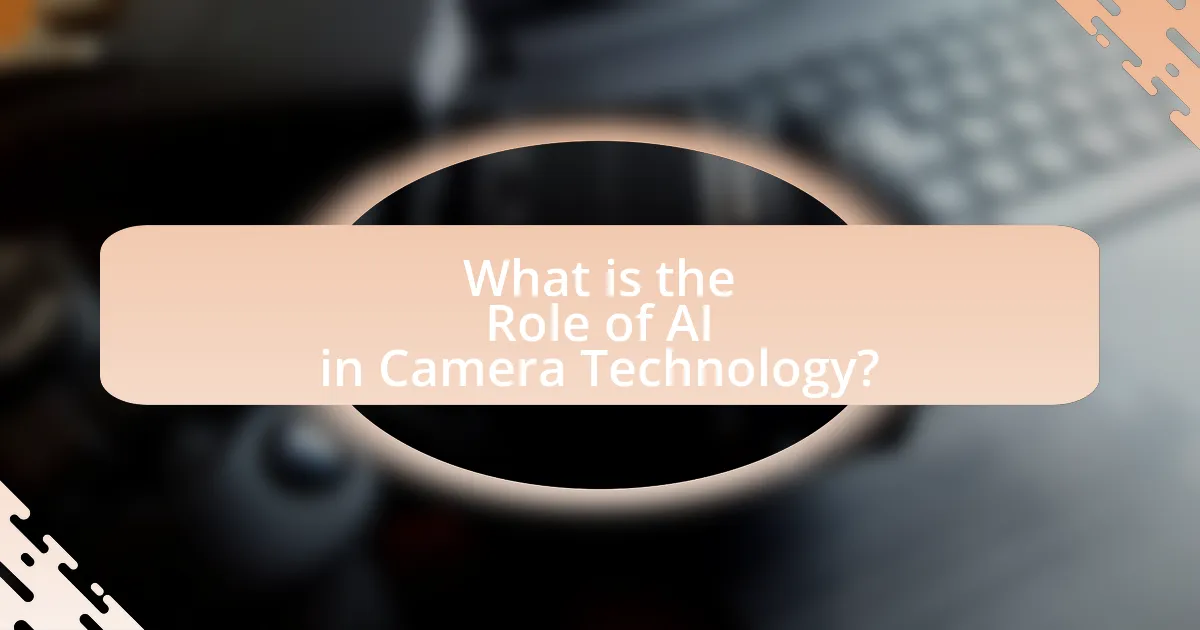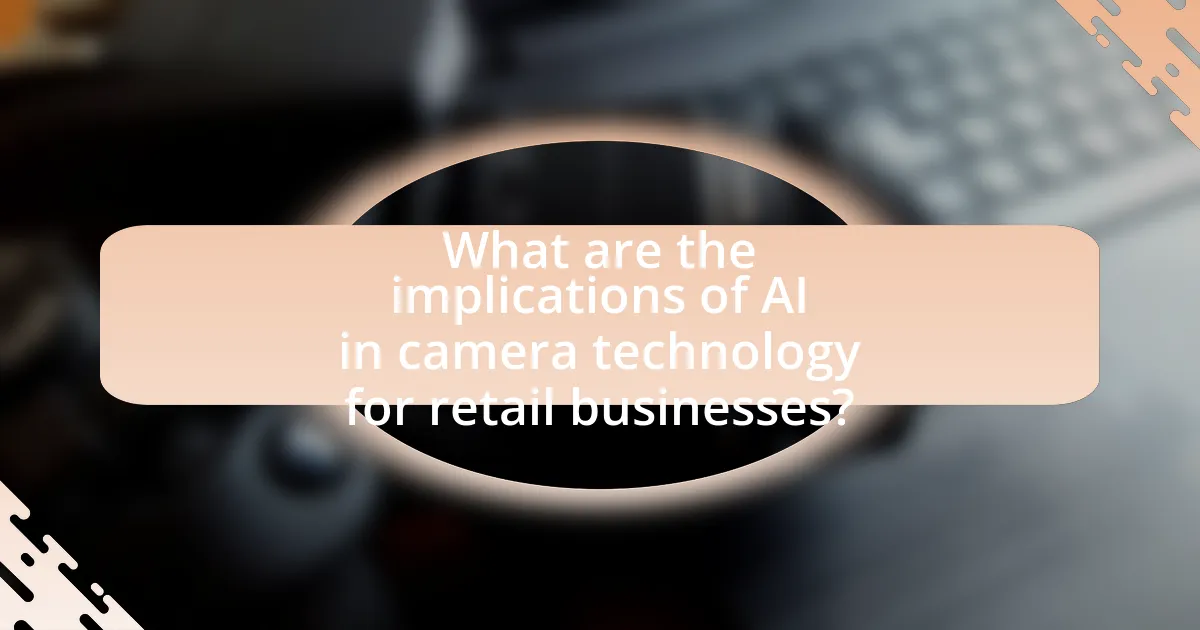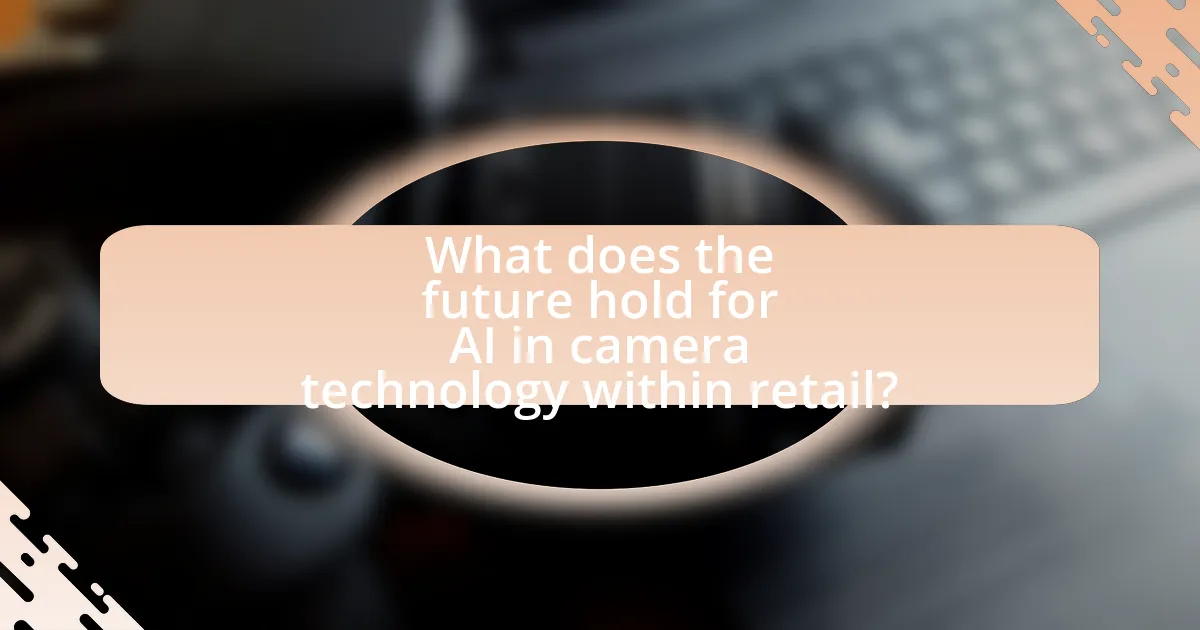The article focuses on the significant role of artificial intelligence (AI) in camera technology, particularly within the retail sector. It explores how AI enhances image processing, automates functionalities, and enables advanced features such as facial recognition and scene detection, ultimately improving user experience and operational efficiency. Key topics include the transformation of traditional camera systems through AI integration, the specific technologies being utilized, and the implications for inventory management and customer insights. Additionally, the article addresses ethical considerations, challenges retailers face in implementation, and future trends in AI-driven camera technology.

What is the Role of AI in Camera Technology?
AI plays a crucial role in camera technology by enhancing image processing, automating focus adjustments, and enabling advanced features like facial recognition and scene detection. These capabilities improve the overall user experience by providing clearer images, faster shooting times, and intelligent adjustments based on the environment. For instance, AI algorithms can analyze scenes in real-time, allowing cameras to optimize settings such as exposure and white balance automatically. Additionally, AI-driven features like object tracking and predictive autofocus significantly enhance photography and videography, making it easier for users to capture high-quality content.
How is AI transforming traditional camera systems?
AI is transforming traditional camera systems by enhancing image processing, enabling real-time analytics, and automating various functionalities. For instance, AI algorithms improve image quality through noise reduction and dynamic range optimization, which significantly enhances the clarity and detail of captured images. Additionally, AI-powered cameras can analyze scenes in real-time, allowing for features such as object recognition, facial detection, and tracking, which are crucial for applications in retail environments. According to a report by MarketsandMarkets, the global AI in the camera market is projected to grow from $1.2 billion in 2020 to $4.5 billion by 2025, indicating a significant shift towards AI integration in camera technology. This transformation not only improves user experience but also provides retailers with valuable insights into customer behavior and preferences.
What specific AI technologies are being integrated into cameras?
Specific AI technologies integrated into cameras include computer vision, machine learning algorithms, facial recognition, object detection, and image enhancement techniques. Computer vision enables cameras to interpret and understand visual data, while machine learning algorithms improve the accuracy of image processing and scene recognition. Facial recognition technology identifies and verifies individuals, enhancing security and personalization features. Object detection allows cameras to recognize and track specific items or people within a frame, which is crucial for applications like surveillance and automated photography. Image enhancement techniques utilize AI to improve image quality by reducing noise, adjusting exposure, and optimizing colors, resulting in clearer and more vibrant photos. These technologies collectively enhance the functionality and user experience of modern cameras.
How do these technologies enhance image quality and processing?
AI technologies enhance image quality and processing by utilizing advanced algorithms for noise reduction, image stabilization, and dynamic range optimization. These algorithms analyze images in real-time, allowing for adjustments that improve clarity and detail. For instance, AI-driven noise reduction techniques can significantly decrease graininess in low-light conditions, resulting in clearer images. Additionally, AI can enhance dynamic range by intelligently balancing highlights and shadows, which is crucial for capturing scenes with varying light levels. Studies have shown that AI-enhanced cameras can produce images with up to 30% more detail compared to traditional methods, demonstrating the effectiveness of these technologies in improving overall image quality.
Why is AI important for retailers using camera technology?
AI is important for retailers using camera technology because it enhances operational efficiency and customer insights. By analyzing video feeds in real-time, AI can identify customer behaviors, optimize inventory management, and improve security measures. For instance, a study by the National Retail Federation found that retailers using AI-driven camera systems reported a 20% increase in sales due to better understanding of customer preferences and shopping patterns. This integration of AI allows retailers to make data-driven decisions, ultimately leading to increased profitability and improved customer experiences.
What advantages does AI provide in retail environments?
AI provides several advantages in retail environments, including enhanced customer experience, improved inventory management, and personalized marketing strategies. Enhanced customer experience is achieved through AI-driven chatbots and virtual assistants that provide real-time support and recommendations, leading to increased customer satisfaction. Improved inventory management is facilitated by AI algorithms that predict demand patterns, reducing stockouts and overstock situations, which can lead to a 10-30% reduction in inventory costs. Personalized marketing strategies are developed using AI analytics to analyze customer data, enabling retailers to tailor promotions and product recommendations, resulting in higher conversion rates and customer loyalty.
How does AI improve customer experience through camera technology?
AI improves customer experience through camera technology by enabling real-time analysis of customer behavior and preferences. This technology allows retailers to track foot traffic, monitor customer interactions, and analyze demographic data, leading to personalized shopping experiences. For instance, AI-powered cameras can identify returning customers and tailor promotions based on their past purchases, enhancing engagement and satisfaction. According to a study by the National Retail Federation, retailers using AI-driven analytics reported a 20% increase in customer satisfaction due to more relevant product recommendations and improved store layouts.
What are the current trends in AI and camera technology for retailers?
Current trends in AI and camera technology for retailers include the integration of advanced analytics, facial recognition, and real-time inventory management. Retailers are increasingly utilizing AI-powered cameras to analyze customer behavior, optimize store layouts, and enhance security measures. For instance, a report by Grand View Research indicates that the global AI in retail market is expected to reach $19.9 billion by 2027, driven by the demand for personalized shopping experiences and operational efficiency. Additionally, the use of computer vision technology allows retailers to automate checkout processes and monitor stock levels, significantly improving customer satisfaction and reducing operational costs.
Which emerging technologies are influencing the future of retail cameras?
Emerging technologies influencing the future of retail cameras include artificial intelligence (AI), machine learning, augmented reality (AR), and advanced imaging sensors. AI enhances image recognition and customer analytics, allowing retailers to personalize shopping experiences and optimize inventory management. Machine learning algorithms improve camera functionalities, enabling features like real-time object detection and facial recognition. Augmented reality provides interactive shopping experiences by overlaying digital information onto physical products through camera interfaces. Advanced imaging sensors, such as those utilizing LiDAR and multispectral imaging, enhance the quality and depth of images captured, facilitating better product visualization. These technologies collectively drive innovation in retail camera applications, improving customer engagement and operational efficiency.
How are retailers adapting to these trends in their operations?
Retailers are adapting to trends in AI and camera technology by integrating advanced analytics and real-time monitoring into their operations. This integration allows retailers to enhance customer experiences through personalized marketing and efficient inventory management. For instance, retailers are utilizing AI-driven cameras to analyze foot traffic patterns, enabling them to optimize store layouts and improve product placement. Additionally, data collected from these technologies helps retailers forecast demand more accurately, reducing overstock and stockouts. According to a report by McKinsey, retailers leveraging AI in their operations can increase their operating margins by up to 60%.
How can retailers effectively implement AI in their camera systems?
Retailers can effectively implement AI in their camera systems by integrating advanced analytics and machine learning algorithms to enhance surveillance and customer insights. This integration allows for real-time monitoring, anomaly detection, and customer behavior analysis, which can lead to improved security and optimized store layouts. For instance, a study by the National Retail Federation found that retailers using AI-driven camera systems reported a 30% reduction in theft and a 20% increase in customer engagement. By leveraging these technologies, retailers can make data-driven decisions that enhance operational efficiency and customer experience.
What challenges do retailers face when integrating AI into camera technology?
Retailers face several challenges when integrating AI into camera technology, including data privacy concerns, high implementation costs, and the need for skilled personnel. Data privacy issues arise as retailers must ensure compliance with regulations like GDPR while collecting and processing customer data through AI-enabled cameras. High implementation costs can deter retailers from adopting advanced AI solutions, as the initial investment in technology and infrastructure can be substantial. Additionally, the lack of skilled personnel to manage and analyze AI systems poses a significant barrier, as retailers require expertise in both AI and camera technology to effectively leverage these tools for operational improvements.

What are the implications of AI in camera technology for retail businesses?
AI in camera technology significantly enhances retail businesses by improving customer experience and operational efficiency. For instance, AI-powered cameras can analyze customer behavior in real-time, allowing retailers to optimize store layouts and product placements based on foot traffic patterns. Additionally, these cameras can facilitate personalized marketing by recognizing returning customers and tailoring promotions accordingly. According to a report by McKinsey, retailers that implement AI-driven analytics can increase their sales by up to 10% through better inventory management and targeted marketing strategies. Thus, the integration of AI in camera technology not only streamlines operations but also drives revenue growth for retail businesses.
How does AI impact inventory management and loss prevention?
AI significantly enhances inventory management and loss prevention by utilizing data analytics and machine learning algorithms to optimize stock levels and detect anomalies. For instance, AI systems can analyze sales patterns and predict demand, reducing overstock and stockouts, which leads to improved operational efficiency. Additionally, AI-powered surveillance systems can identify suspicious behaviors in real-time, allowing retailers to respond promptly to potential theft or fraud. According to a report by McKinsey, retailers implementing AI in inventory management can reduce inventory costs by 20-50% while improving service levels. This demonstrates that AI not only streamlines inventory processes but also strengthens loss prevention strategies effectively.
What role does AI play in real-time analytics for retailers?
AI plays a crucial role in real-time analytics for retailers by enabling the processing and analysis of vast amounts of data instantly. This capability allows retailers to gain insights into customer behavior, inventory levels, and sales trends as they happen. For instance, AI algorithms can analyze data from in-store cameras and sensors to track foot traffic and customer interactions, providing retailers with actionable insights that can enhance customer experience and optimize operations. According to a report by McKinsey, retailers that leverage AI for real-time analytics can improve their decision-making speed by up to 50%, leading to increased sales and customer satisfaction.
How can AI-driven cameras enhance security measures in retail?
AI-driven cameras enhance security measures in retail by utilizing advanced algorithms for real-time monitoring and threat detection. These cameras can analyze video feeds to identify suspicious behavior, such as shoplifting or unauthorized access, with a higher accuracy rate than traditional surveillance systems. For instance, a study by the National Institute of Standards and Technology found that AI-based systems can reduce false alarm rates by up to 90%, allowing security personnel to focus on genuine threats. Additionally, AI-driven cameras can integrate with other security systems, providing a comprehensive approach to retail security that includes facial recognition and customer behavior analysis, further improving loss prevention strategies.
What ethical considerations arise from using AI in camera technology?
The ethical considerations arising from using AI in camera technology include privacy concerns, bias in algorithmic decision-making, and accountability for misuse. Privacy concerns stem from the potential for surveillance and unauthorized data collection, as AI-enabled cameras can capture and analyze personal information without consent. Bias in algorithmic decision-making can lead to discriminatory outcomes, as AI systems may reflect the prejudices present in their training data, impacting marginalized groups disproportionately. Accountability for misuse is crucial, as it raises questions about who is responsible when AI technology is used for harmful purposes, such as invasion of privacy or perpetuating stereotypes. These considerations highlight the need for ethical guidelines and regulations in the deployment of AI in camera technology.
How can retailers ensure customer privacy while using AI cameras?
Retailers can ensure customer privacy while using AI cameras by implementing strict data protection policies and utilizing anonymization techniques. These measures include encrypting video footage, limiting access to authorized personnel, and ensuring that AI systems do not store identifiable information unless necessary. According to a report by the International Association of Privacy Professionals, 79% of consumers express concern about their privacy when being monitored, highlighting the importance of transparency and consent in data collection practices. By clearly communicating how data is used and obtaining customer consent, retailers can foster trust while leveraging AI technology.
What regulations should retailers be aware of regarding AI and surveillance?
Retailers should be aware of regulations such as the General Data Protection Regulation (GDPR) in Europe, which governs the collection and processing of personal data, including data obtained through AI surveillance systems. Additionally, the California Consumer Privacy Act (CCPA) imposes requirements on businesses regarding consumer data privacy and transparency in the United States. These regulations mandate that retailers must obtain consent from individuals before collecting their data, provide clear disclosures about data usage, and ensure data security measures are in place. Compliance with these laws is critical, as violations can result in significant fines and legal repercussions.

What does the future hold for AI in camera technology within retail?
The future of AI in camera technology within retail is poised for significant advancements, particularly in enhancing customer experience and operational efficiency. AI-powered cameras will increasingly enable real-time analytics, allowing retailers to monitor customer behavior, optimize store layouts, and personalize marketing strategies. For instance, a study by McKinsey & Company indicates that retailers utilizing AI for customer insights can increase sales by up to 10%. Additionally, AI will facilitate improved inventory management through automated stock monitoring and loss prevention, reducing shrinkage rates. As these technologies evolve, retailers will likely adopt more sophisticated AI algorithms that integrate seamlessly with existing systems, driving innovation and competitive advantage in the retail sector.
How will advancements in AI shape the next generation of retail cameras?
Advancements in AI will significantly enhance the next generation of retail cameras by enabling features such as real-time analytics, improved image recognition, and automated inventory management. These cameras will utilize machine learning algorithms to analyze customer behavior, allowing retailers to optimize store layouts and product placements based on data-driven insights. For instance, AI-powered cameras can identify customer demographics and preferences, leading to personalized marketing strategies. Additionally, advancements in computer vision will allow cameras to detect stock levels and trigger automatic reordering processes, thereby streamlining inventory management. This integration of AI into retail cameras is supported by the growing trend of smart retail technologies, which are projected to increase operational efficiency and enhance customer experiences.
What potential innovations can we expect in AI camera technology?
Potential innovations in AI camera technology include enhanced image recognition capabilities, real-time object detection, and improved low-light performance. These advancements will enable cameras to identify products more accurately and efficiently, facilitating better inventory management and personalized customer experiences in retail settings. For instance, AI algorithms can analyze customer behavior and preferences, allowing for targeted marketing strategies. Additionally, the integration of augmented reality features can provide interactive shopping experiences, further engaging consumers. These innovations are supported by ongoing research and development in machine learning and computer vision, which continue to push the boundaries of what AI cameras can achieve in retail environments.
How might consumer expectations evolve with AI advancements?
Consumer expectations will likely evolve towards a demand for greater personalization and enhanced user experiences as AI advancements progress. As AI technologies improve, consumers will expect products that not only meet their needs but also anticipate them, leading to a more tailored shopping experience. For instance, AI-driven camera technology can analyze consumer preferences and suggest features or settings that align with individual styles, thereby increasing satisfaction. Additionally, studies indicate that 70% of consumers prefer personalized experiences, highlighting the importance of AI in meeting these evolving expectations.
What best practices should retailers follow when adopting AI camera technology?
Retailers should prioritize data privacy and compliance when adopting AI camera technology. Ensuring that customer data is collected, stored, and processed in accordance with regulations such as GDPR is essential to maintain trust and avoid legal repercussions. Additionally, retailers should invest in high-quality hardware and software to ensure accurate data capture and analysis, as studies show that better technology leads to improved operational efficiency and customer insights. Training staff on the ethical use of AI technology is also crucial, as it fosters a culture of responsibility and enhances the effectiveness of AI applications in retail settings.